Discover Florida Nature
It's time to explore the natural Florida


|
|
|
|
|
Toads are a beneficial amphibian for humans because they eat a large
quantity of insects. handling Toads or warts does not cause warts!
However a few Florida toads and frogs produce toxic or foul smelling
substances in their skin, so it is always wise to wash your hands after
handling them. The following Florida toads and frogs have the most
irritating skin secretions: Marin Toad, Eastern Spadefoot Toad, Cuban
Treefrog, and River Frog.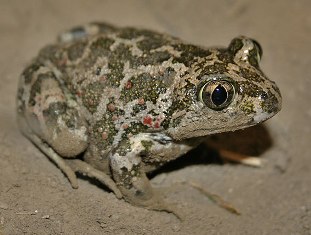 Eastern
Spadefoot Toad- The Eastern Spadefoot Toad gets his name from a
specialized "spade" on the heel of each hind foot, which is used for
digging backwards into the soil, as deep as eight inches. Although quite
common Spadefoot Toads are rarely seen because they spend most of their
time underground during the day, emerging only on warm humid nights to
feed. A combination of very heavy rainfall and low barometric pressure
lures them by the thousands to perform their intense mating ritual. This
might only occur one or two nights a year. Hordes of spadefoot toads may
appear out of nowhere, hopping across country roads just after dark, as
they head for flooded fields, saturated lawns and drainage ditches.
Spadefoot Toads can be distinguished by their yellowish eyes and
vertical pupils. They sometimes have a wild eyed look, but are in fact
quite harmless. In Florida spadefoot males tend to be yellowish and
females more of a brownish. Eastern
Spadefoot Toad- The Eastern Spadefoot Toad gets his name from a
specialized "spade" on the heel of each hind foot, which is used for
digging backwards into the soil, as deep as eight inches. Although quite
common Spadefoot Toads are rarely seen because they spend most of their
time underground during the day, emerging only on warm humid nights to
feed. A combination of very heavy rainfall and low barometric pressure
lures them by the thousands to perform their intense mating ritual. This
might only occur one or two nights a year. Hordes of spadefoot toads may
appear out of nowhere, hopping across country roads just after dark, as
they head for flooded fields, saturated lawns and drainage ditches.
Spadefoot Toads can be distinguished by their yellowish eyes and
vertical pupils. They sometimes have a wild eyed look, but are in fact
quite harmless. In Florida spadefoot males tend to be yellowish and
females more of a brownish.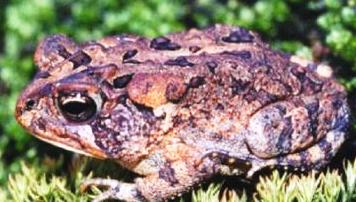 Southern
Toad- The Southern Toad is a medium sized toad, and is the most
familiar toad in Florida. Found in all habitat throughout the state, the
Southern Toad prefers sandy areas, cultivated fields, pine barrens and
hammocks. The Southern toad is the one most likely to be seen
hopping around homes at night, looking for a meal under
insect-attracting lights. In the daytime or in dry weather, the Southern
Toad usually burrows into the ground. This toad is usually grayish, but
dark brown or reddish specimens can be found. The prominent feature of
the Southern toad is the ridges between the eyes which end in
conspicuous knobs behind the eyes. These knobs are called cranial knobs.
On rainy nights, the Southern toad calls out in a continuous
high-pitched trill that can be deafening up close or in chorus! Southern
Toad- The Southern Toad is a medium sized toad, and is the most
familiar toad in Florida. Found in all habitat throughout the state, the
Southern Toad prefers sandy areas, cultivated fields, pine barrens and
hammocks. The Southern toad is the one most likely to be seen
hopping around homes at night, looking for a meal under
insect-attracting lights. In the daytime or in dry weather, the Southern
Toad usually burrows into the ground. This toad is usually grayish, but
dark brown or reddish specimens can be found. The prominent feature of
the Southern toad is the ridges between the eyes which end in
conspicuous knobs behind the eyes. These knobs are called cranial knobs.
On rainy nights, the Southern toad calls out in a continuous
high-pitched trill that can be deafening up close or in chorus!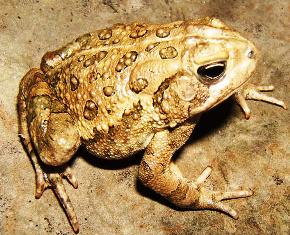 Fowler's
Toad- Fowler's toad is usually brown or gray and can be
distinguished by the dark spots on its back, with each spot containing
several warts. Fowler's Toad lacks the pronounced cranial knobs of the
Southern Toad. This toad has a line running down its back like the oak
toad, but it is not as prominent. Fowler's toad is an attractive toad
and is very common through out its range in the eastern United States.
The adults eat insects and other small terrestrial invertebrates, but
shy away from earthworms. The tadpoles are also known to feed on
bacteria and other organic material from the water. Fowler's
Toad- Fowler's toad is usually brown or gray and can be
distinguished by the dark spots on its back, with each spot containing
several warts. Fowler's Toad lacks the pronounced cranial knobs of the
Southern Toad. This toad has a line running down its back like the oak
toad, but it is not as prominent. Fowler's toad is an attractive toad
and is very common through out its range in the eastern United States.
The adults eat insects and other small terrestrial invertebrates, but
shy away from earthworms. The tadpoles are also known to feed on
bacteria and other organic material from the water.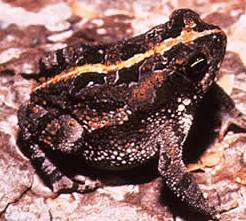 Oak
Toad-The Oak Toad is the smallest species of toad in the United
States, growing to only 1.75 inches in length. Found in
pinewoods and
oak hammocks, the
oak toad is darker, and much smaller than the Southern Toad. the Oak
Toad has a conspicuous light-colored line running lengthwise down the
middle of it's back. This toad's call sounds like the peeping of a
chick, but much louder. While calling the male oak toad's throat pouch
extends upward in front of his face, like a small inflated sausage! Oak
toads, unlike most toad species, are usually active during the day.
Breeding takes place in shallow pools that result from heavy rains. Oak
Toad-The Oak Toad is the smallest species of toad in the United
States, growing to only 1.75 inches in length. Found in
pinewoods and
oak hammocks, the
oak toad is darker, and much smaller than the Southern Toad. the Oak
Toad has a conspicuous light-colored line running lengthwise down the
middle of it's back. This toad's call sounds like the peeping of a
chick, but much louder. While calling the male oak toad's throat pouch
extends upward in front of his face, like a small inflated sausage! Oak
toads, unlike most toad species, are usually active during the day.
Breeding takes place in shallow pools that result from heavy rains. 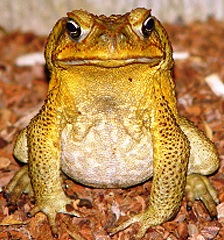 Marine
Toad (Giant Toad)- The big Marine Toad was introduced into
Florida many years ago. Originally this toad ranged from South Texas to
southern South America. The giant toad has been described as "the most
introduced amphibian in the world". The marine toad eats certain beetles
that damage sugar cane and may have been brought to Florida for this
reason. The marine toad is a rusty orange color and produces a milky
secretion in its parotid gland that is quite toxic and can sicken or
even kill a dog or cat unlucky enough to bite into one. People need to
be sure and carefully wash their hands after handling the giant marine
toad. The giant marine toad has a stout body and short legs, with the
digits of the forelimbs lacking webbing and those of the hind limbs
being webbed. The skin is rough and warty. In Florida the marine toad
can get up to eight inches long and weigh up to five pounds. Marine
Toad (Giant Toad)- The big Marine Toad was introduced into
Florida many years ago. Originally this toad ranged from South Texas to
southern South America. The giant toad has been described as "the most
introduced amphibian in the world". The marine toad eats certain beetles
that damage sugar cane and may have been brought to Florida for this
reason. The marine toad is a rusty orange color and produces a milky
secretion in its parotid gland that is quite toxic and can sicken or
even kill a dog or cat unlucky enough to bite into one. People need to
be sure and carefully wash their hands after handling the giant marine
toad. The giant marine toad has a stout body and short legs, with the
digits of the forelimbs lacking webbing and those of the hind limbs
being webbed. The skin is rough and warty. In Florida the marine toad
can get up to eight inches long and weigh up to five pounds. |
|
|
Advertise | Privacy Statement | Contact | Alaska Nature | Michael Arnold Art| Dog Encyclopedia | Dog Encyclopedia| |
|